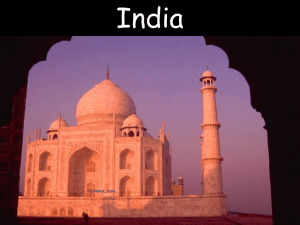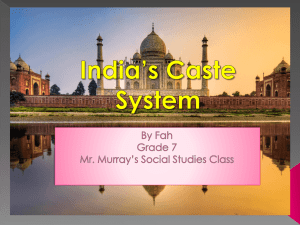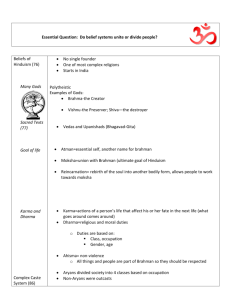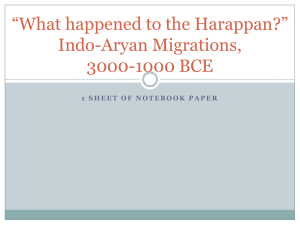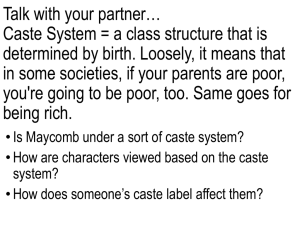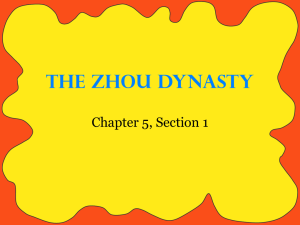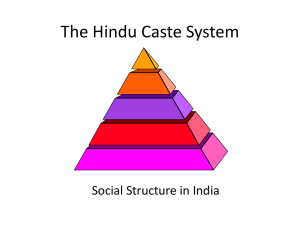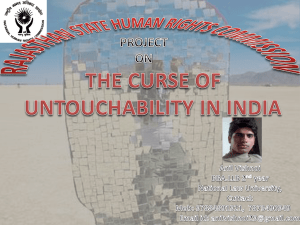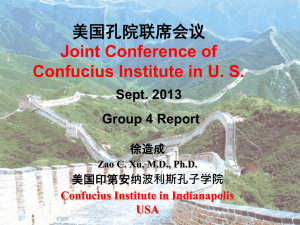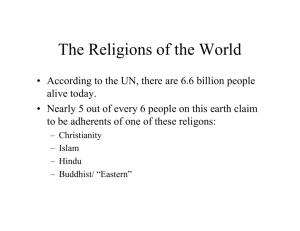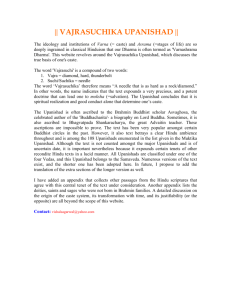Global History 9 – Year in Review (so far)
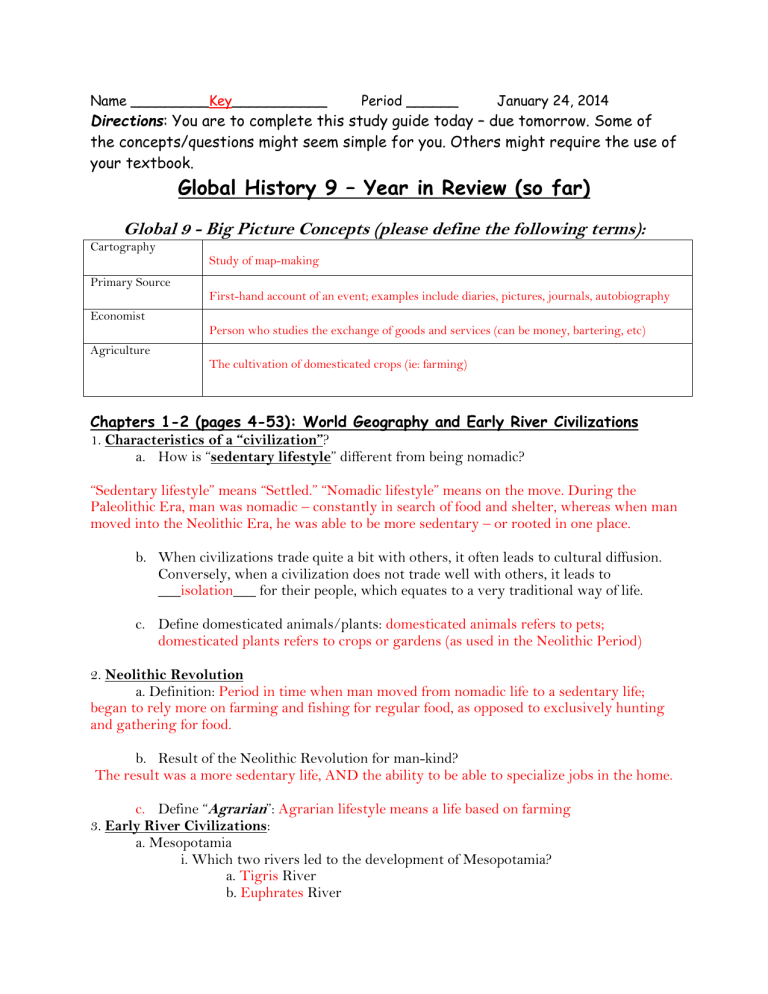
Name _________ Key ___________ Period ______ January 24, 2014
Directions: You are to complete this study guide today – due tomorrow. Some of the concepts/questions might seem simple for you. Others might require the use of your textbook.
Global History 9 – Year in Review (so far)
Global 9 - Big Picture Concepts (please define the following terms):
Cartography
Study of map-making
Primary Source
Economist
Agriculture
First-hand account of an event; examples include diaries, pictures, journals, autobiography
Person who studies the exchange of goods and services (can be money, bartering, etc)
The cultivation of domesticated crops (ie: farming)
Chapters 1-2 (pages 4-53): World Geography and Early River Civilizations
1. Characteristics of a “civilization” ? a.
How is “ sedentary lifestyle ” different from being nomadic?
“Sedentary lifestyle” means “Settled.” “Nomadic lifestyle” means on the move. During the
Paleolithic Era, man was nomadic – constantly in search of food and shelter, whereas when man moved into the Neolithic Era, he was able to be more sedentary – or rooted in one place. b.
When civilizations trade quite a bit with others, it often leads to cultural diffusion.
Conversely, when a civilization does not trade well with others, it leads to
___ isolation ___ for their people, which equates to a very traditional way of life. c.
Define domesticated animals/plants: domesticated animals refers to pets; domesticated plants refers to crops or gardens (as used in the Neolithic Period)
2. Neolithic Revolution a. Definition: Period in time when man moved from nomadic life to a sedentary life; began to rely more on farming and fishing for regular food, as opposed to exclusively hunting and gathering for food. b.
Result of the Neolithic Revolution for man-kind?
The result was a more sedentary life, AND the ability to be able to specialize jobs in the home. c.
Define “ Agrarian ”: Agrarian lifestyle means a life based on farming
3. Early River Civilizations : a. Mesopotamia i. Which two rivers led to the development of Mesopotamia? a. Tigris River b. Euphrates River
ii. Babylon a. What was the purpose of the “Code of Hammurabi”?
The code of Hammuarbi was established in ancient Mesopotamia as the first code of laws that helped guide behavior. b. How was the Code of Hammurabi similar to Rome’s 12 Table?
Both the Code of Hammurabi and Rome’s twelve tables were established as codes of laws to govern behavior … like the monotheistic 10 Commandments, or the US Constitution. b. Egypt i. The development of the _ Nile ___ River led to civilization in Egypt. ii. Egyptians were polytheistic; ie: believed in more than one __ God ______ c. Indus River Valley i. The development of the ___ Indus ___ and __ Ganges _Rivers led to civilization in the Indus River Valley. a. The Ganges is considered a __ ii. What technological advancement is the city of Mohenjo Daro known for? They developed the grid system and underground plumbing – early aqueduct system sacred/holy _ river d. In Mesopotamia and Egypt fertile soil was referred to as silt. In China, the fertile soil from the Yangtze River & the Huang He Rivers was known as Loess.
d.
How did the “Mandate of Heaven” impact the leadership of China?
The Mandate of Heaven dictated who was Emperor, and for how long. As long as God was happy with the performance of the emperor, he would keep the Mandate. To signify that God had a different “mandate”, he would send a natural disaster or war, and that would indicate to the people that the Mandate of Heaven was no longer with that ruler. e.
How did an Emperor lose power under the Mandate of Heaven? See above question.
f.
Define the term Dynasty: Ruling family (used in Ancient China and Egypt)
Chapter 3, Sections 1 - 3 (page 56 – 69): a.
Indo-Europeans were divided into two groups: a.
The Aryans went to India b.
The Hittites settled: Anatolia (modern day Turkey) b.
Aryan invasion of India … these lighter skinned people came from the Caucuses
Mountains. Early on, the Aryans developed a class system in India, in which they were at the top, and darker skinned natives were at the bottom. This class system was called a Caste System. The system evolved and people were BORN into a Caste.
How was this social system DIFFERENT from other class systems in the world? In most other societies, social classes are mobile. Castes are permanent, and cannot be changed until a person is reincarnated.
c.
How did Hindu’s use the Caste system and concept of karma to keep people in line?
Hindu’s believe that if a person behaves well on earth, they receive good karma, and that will impact their reincarnation cycle – in that they will be reincarnated into a higher caste the next life, until they reach ultimate enlightenment (called Moksha) and can be released from their earthly body. Conversely, if you are bad, you receive bad karma and will be in a lower caste in the next life as a punishment. d.
Siddhartha Gautama was born a HINDU! How did his beliefs about the Caste
System and Reincarnation DIFFERENT from those of other Hindu’s (p64)?
Siddhartha Guatama – or “The Buddha” rejected the ideas of the Caste System, and believed reincarnation and Karma were individual journeys that would continue until you reached ultimate enlightenment (Nirvana). NO CASTES for Buddhists! e.
Why did Buddha’s earliest followers include laborers, craftspeople and women?
Buddha’s followers were the lowest ranking members of Hindu Society because he rejected the
Caste system and considered everyone equal. f.
(Pages 68-69) Around 1100 BC, the Phoenicians had beat out the Minoans as the most powerful trading group in the Mediterranean Sea. What is considered their
GREATEST legacy? They’re credited with developing the first version of the modern alphabet.
Chapter 4: Age of Empires
1.
(Page 88) The Assyrians were best known for developing a large empire through: conquest and warfare (technology example: battering rams)
2.
(Pages 93-94) Read the section titled “Persian Rule and Religion. After the Persians conquered the Assyrian land and much of Asia, how did they unify the land?
The Persians conquered and unified their land through diplomacy and peaceful treaties…and then built a royal highway and used a common currency.
3.
Look over the information on page 95 about Persia’s Royal Road. What was the point of building “posts” or “relay stations”? R est stops along highways
4.
What type of vehicles did the Persians use to navigate the Royal Road? Chariots
5.
(Pages 97-98) Following the tumultuous Zhou Dynasty in China, Confucius preached that in order to achieve social order and harmony, people should do what?
Create respectful relationships with everyone in their lives.
a.
Three of Confucius’ relationships were based on family. Confucius stressed that children should practice “filial piety”, or respects for one’s: Families and elders b.
Confucius also developed the idea of using a Bureaucracy in government, and having people take a “civil service” exam. What is a civil service exam ?
Test that determined a person’s ability to serve in the government.
6.
(Page 100) Instead of China embracing Confucius’ ways in order to restore order to
China, they leaned more towards a strict and angry government called “Legalism”.
Their leader during this time, Shi Huangdi, established an “ autocracy ”. What is that? An “autocrat” is a ruler that makes ALL decisions – like a dictator.
7.
What project is Shi Huangdi credited with finishing in China? The Great Wall a.
Why was this “project” built? The Great Wall acted as a protective barrier against the invading Mongols from the North.
Chapter 5 – Greece and Chain of Events:
Greece’s geography GREATLY impacted its unification. WHY?
The mountainous geography of Greece made it impossible to unify the city-states, thus creating independent kingdoms all over the region.
What made Athens/Sparta such powerful city-states (polis)?
Both Sparta and Athens were powerful for different reasons.
1.
Athens was powerful due to its emphasis on education, democracy, architecture, arts
(including theater) mathematics and architecture. They valued their citizens and each person’s independent thought.
2.
Sparta was powerful because of its military might and strategy (specifically, the use of the Phalanx formation was most impressive) and use of a balanced government system
(different branches held different powers).
*As a result of the Peloponnesian Wars, Greece destroyed itself, and left the country open to attack from their Macedonian neighbors to the north (Alexander the Great’s father).
Legacies of Greece: o Art/Architecture: Classical sculpture, columns utilized; Euclid’s Geometry was developed to make sure angles on architecture designs were perfect o Government: Democracy o Philosophy: the ideas of Socrates formed the basis for future scientific thought (The Scientific Method); Hippocrates as the “father of medicine”
Socrates, Plato and Aristotle – These three Greek Philosophers challenged the studets of Athens to speak their minds and challenge the traditions of their elders.
*Aristotle’s student, Alexander is credited with beginning the Hellenic Period:
Where did this impact? Persia, India, Greece and Egypt
While the Hellenic period did not last long in history, it left an important legacy.
What is this legacy? The culture was rich with various histories
*As the Hellenic Era began to decline, a new empire began to gain power on the Italian
Peninsula…. Name it: Rome
